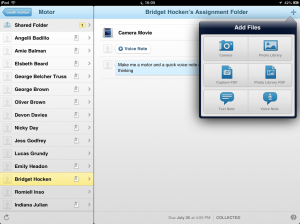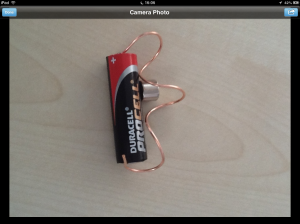An overview of waves and sound with some ideas of how you might teach them. Please add ideas to the comments or through twitter @natkin.
If we follow the philosophy of Feynman it is not about transferring knowledge without a context. If we use this approach we can go beyond simply being able to answer exam questions into the realms of learning.
I find intuition a good starting point and have written a blog post on it here
Starting with waves
Get the students to wave to you and they all can. So they understand the concepts of waves. Have a discussion of what makes a wave, a wave.
Concept that it is a repeated oscillation about a point in language appropriate to your students
How might we describe a wave?
The students sit back to back . One can see the video of the queen waving and has to describe to the one who cannot see who has to try and match what is on the screen. I stand behind them telling them when they have got it right
If you try describing how the Queen waves in a way that everyone else can understand . Its a pain saying “She waves her hand backwards and forwards repeatedly and quickly at the same rate without making it go very far from the central position”
Then introduce the terms
Frequency – Number of times something happens in a given time. What is the frequency of your lessons? 5 per day. Frequency of buses ? 2 per hour. Frequency of waves? Number of complete waves /cycles per second.
Amplitude – Students often confuse this with height and they need to ensure it means the maximum displacement from the rest position
Now we can say of the Queen “She has a high frequency, but low amplitude wave” (it seems to have changed over the years , most people remember it as slower with a higher amplitude )
Next was a demo of a slinky how might we transfer energy down the slinky? 2 ways side to side/up down or in and out
Ways of transferring energy using a slinky
Relate these to terms transverse and longitudinal waves and how there is no mass transfer of molecules, simply energy transfer. A bit of masking tape demonstrates this well.
Revise the ideas of high low frequency and amplitude with the slinky.
This may be a good time to explore the relationship between frequency and energy . This is fairly intuitive – If you walk into the sea and waves hit you more frequently then you will clearly notice that higher frequencies transfer more energy. Relating this to the electromagnetic spectrum waves of frequency greater than that of visible light – Ultra violet and higher can be dangerous.
We can also see wavelength clearly demonstrated on a slinky
You can see nice standing waves using an electric toothbrush and elastic outlined here
You can also demonstrate wavelength and it’s relationship to velocity using a hand wave. Give them a pen to hold over a sheet of paper. Pull the paper with an increasing speed and you will see an increasing wavelength being drawn on the paper (see below) You can also relate this to the wave equation
Velocity (m/s) = Frequency (Hertz) x Wavelength (m)
The frequency is constant and the wavelength increases as the velocity increases
Excerpt from a lesson
Having had the terms described using Pose/Pause /Pounce / Bounce to gather their ideas they were then given 2 minutes to perform waves of high/low frequency, large/small amplitude and long/short wavelengths. Some interesting ideas were demonstrated with students also whistling high and low frequencies. I know I am teaching well when my students surprise me.
Jelly Baby Wave machine
Then they were given a length of duct tape, barbeque skewers and jelly babies to make the jelly baby wave machine. seen here

This is an ideal experiment to get the students to build the problem. What might happen if …?
Ideas:
The distance between the sticks was changed
The tension was changed
The jelly babies were moved closer to the centre
Half of each jelly baby was eaten
Sound
Following the concept of waves leads us into sound a longitudinal wave. Show with a slinky
Other possible demos
Frequency and Sound
Hum the National Anthem with your hand on your throat. Hum in louder (higher amplitude) , higher frequency etc. What do you notice?
Vibrations of your vocal cords. What would happen if you have no vocal cords after say a larnygectomy
How can you make a metal rod sing?
Hearing Tests
If there is only one thing to tell students it is that every loud sound damages your hearing. In quiet societies old peoples hearing is far better than it is in noisy societies .
An online hearing test is here
The worlds quietist room where you can hear your organs !
Following this you can go into the realms of making music and the straw oboes
http://www.physics.org/interact/physics-to-go/straw-oboes/
Ask the question what would happen if…?
The straw became very short? – Would go into ultrasound
The straw became very long? – Would go into infrasound – which may attract elephants
Can you shatter a glass with just your voice?
This can lead you into resonance and the must use footage of the Tacoma Narrows Bridge
and this truly spectacular demonstration
Taken from here
Or make a very annoying sound from a piece of paper that will make the other teachers hate you
Speed of Sound
You can use Audacity – free and brilliant software to measure the speed of sound
National STEM Centre resource here or
Or by echoes
Apps for Sound
String for iPad – Simple app that lets you play with waves on a string here
Higher level em spectrum stuff from Loughborough here
Fourier Touch – Great for showing beat frequencies and playing with sound waves here
Review of these 3 here
There are a few oscilloscope apps around. I use oscope here
Lots of sound level apps that are great to leave on to keep class noise levels at a reasonable level. Decibel 10 gives you peak values etc here
Not sound as such but the seismometer app is useful here
Uses of Sound
10 wonderful uses here
Really interesting list here might need some verification
Making instant coffee in mid air – Acoustic Levitation here
As a weapon – Anti piracy or demonstration devices LRAD (Long range acoustic devices) – report here
Feel free to add ideas to this through comments etc – I’m constantly updating it








